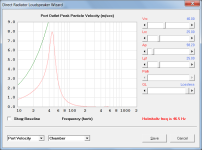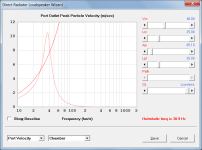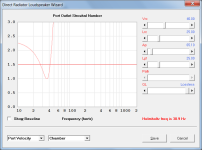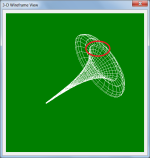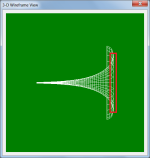This would be an incredibly high BL 10 inch I think. Possible to do, but what happens when you raise the BL to very high levels your Fs goes up, your efficiency also goes up. Fs free air and in an enclosure are two very different things, but you need to understand that as well. I have done 18 inch subwoofers with a Qts of 0.123. Over damped. But they could move a lot of air.
I guess in the prolapse driver shop
🤣
Hi! Im new to hornresp and not very good in mathematics or speaker theory in general, so pleasy forgive me, but im trying to learn 🙂
I am going to build the Inlow 135hz Horn, and in time some conical horns for double 15incc drivers. This is my rig today:
View attachment 1317354
but I have decided to try out conical midbasshorns, 15inch for 80hz-250hzish, and 8inch in inlowhorns for 250hz-600hz. I want to see if this can give more detailed male vocal pronouncement than 15inch alone. Im considering several options:
View attachment 1317357
But for now im trying to simulate the 135hz Inlowhorns in hornresp to understand what parameters are good, and whats not.
I have had quite large conicals with 15" mid bass drivers.
Then shorter exponential with 15s which developed into longer 12".
The 15" driver conicals and the longer 12" driver exponentials were the pick of the straight horns.
Now I'm using the SH50s with 12" drivers.
Part horn, part bass reflex that do down close to 50Hz and upto 325Hz.
These are the pick for me.
It's a bit horses for courses but overall performance and the kick bass is best from the SH50s!
Hornresp Update 5610-240612
Hi Everyone,
CHANGE
Strouhal number limit lines can now be added to the loudspeaker wizard port outlet velocity and Strouhal number charts by pressing the L key when either chart is visible.
The default Strouhal number limit value is 1 but it can be changed to 1.5 or 2 by the user for the duration of the Hornresp session by pressing the plus (+) or minus (-) keys.
On the port outlet velocity chart if the peak particle velocity is less than the specified limit then the limit line will be green, otherwise it will be red. Attachments 1 and 2 refer.
On the Strouhal number chart if the Strouhal number is greater than the specified limit then the limit line will be green, otherwise it will be red. Attachments 3 and 4 refer.
Kind regards,
David
Hi Everyone,
CHANGE
Strouhal number limit lines can now be added to the loudspeaker wizard port outlet velocity and Strouhal number charts by pressing the L key when either chart is visible.
The default Strouhal number limit value is 1 but it can be changed to 1.5 or 2 by the user for the duration of the Hornresp session by pressing the plus (+) or minus (-) keys.
On the port outlet velocity chart if the peak particle velocity is less than the specified limit then the limit line will be green, otherwise it will be red. Attachments 1 and 2 refer.
On the Strouhal number chart if the Strouhal number is greater than the specified limit then the limit line will be green, otherwise it will be red. Attachments 3 and 4 refer.
Kind regards,
David
Attachments
Maybe for those who haven't totally followed the background story behind this, it would be handy to give a small and brief summary what it is and why it could be important?Strouhal number limit lines can now be added to the loudspeaker wizard port outlet velocity and Strouhal number charts by pressing the L key when either chart is visible.
A short explanation is provided in the hornresp help file.small and brief summary
I am furthermore proud to direct to post 14777 with a link to my thread regarding port geometry including investigation of strouhal number.
Great. That's handy to know, but isn't evident. 🙂A short explanation is provided in the hornresp help file.
Also, I think most people here even never heard of the word to begin with.
I clicked on your link. But it just goes to an update message, followed by another update message?
Yes, that was the first hornresp update including strouhal number output.it just goes to an update message
In the description of updates david mentioned:
But I agree, strouhal number is not (yet) that well known in the diy community.For further specific details on the Hornresp Strouhal number feature, search for the text string stro (the minimum required) using the Help File > Find tool.
We need to start a strouhal number thread!
But I still would like to test some more ports to get a reliable and usable strouhal number limit.
Well in almost any field incl professionals 😉But I agree, strouhal number is not (yet) that well known in the diy community.
I doubt most loudspeaker engineers are even very familiar with it, unless they have a solid background in thermodynamics.
Btw, this is not bad criticism but I think it's important to have at least a easy to understand explanation ready.
For example what does a low vs high number mean and why is the limit at a St of 1?
I think that's better than sending people into the woods (= thread)
I have been following this part of your topic on the sideline, so I can't just quickly come up with something myself without running the risk of getting some of the nuances wrong.
Ok, so here is a quick sum up of strouhal number concept as described in papers including comments following my test results:
Strouhal number is used to determin the limit of laminar oscillating air flow at a port exit and it is defined as
St = (Port radius) / (air particle displacement)
*Particle displacement: peak one way displacement
papers state that below a strouhal number of 1 there will be an unsteady separation of airflow.
Following my tests this lowers port output, creates noise and increases distorsion (mainly H3).
For serious music reproduction the strouhal number should always stay above 1 and preferrably further above (1.5 - 2 - but that's still to be evaluated).
Strouhal number is referring to the port exit thus it will only be calculated for external port end air velocity in hornresp.
The negative effects associated when crossing strouhal number 1 are slightly less severe with straight low roundover radius tube ports, but those ports start to compress, distort and make chuffing noises already at very low levels.
So following my experience keeping strouhal number above 1 (or higher) is most relevant with high quality flared ports.
Strouhal number is used to determin the limit of laminar oscillating air flow at a port exit and it is defined as
St = (Port radius) / (air particle displacement)
*Particle displacement: peak one way displacement
papers state that below a strouhal number of 1 there will be an unsteady separation of airflow.
Following my tests this lowers port output, creates noise and increases distorsion (mainly H3).
For serious music reproduction the strouhal number should always stay above 1 and preferrably further above (1.5 - 2 - but that's still to be evaluated).
Strouhal number is referring to the port exit thus it will only be calculated for external port end air velocity in hornresp.
The negative effects associated when crossing strouhal number 1 are slightly less severe with straight low roundover radius tube ports, but those ports start to compress, distort and make chuffing noises already at very low levels.
So following my experience keeping strouhal number above 1 (or higher) is most relevant with high quality flared ports.
Last edited:
I'm learning as we go here gentlemen. But also enjoying what I am learning. 99% of why I stick around here.Well in almost any field incl professionals 😉
I doubt most loudspeaker engineers are even very familiar with it, unless they have a solid background in thermodynamics.
Hornresp Update 5610-240624
Hi Everyone,
BUG FIX
Depending upon the axial length of the horn, the 3-D Wireframe View could sometimes display a discontinuity in the Le Cléac'h contour, as shown in Attachments 1 and 2.
This bug has now been fixed, as shown in Attachments 3 and 4.
Kind regards,
David
Hi Everyone,
BUG FIX
Depending upon the axial length of the horn, the 3-D Wireframe View could sometimes display a discontinuity in the Le Cléac'h contour, as shown in Attachments 1 and 2.
This bug has now been fixed, as shown in Attachments 3 and 4.
Kind regards,
David
Attachments
Hey DMB,
What is the correct input for Re when using 6 isobaric 3.6 ohm drivers in a 3P 2s Loudspeaker Configuration?
When using 2.4 ohm, Rg + Re match Power in watts: 1500.
When using 3.6 ohm, Rg + Re does not match Power in watts: 1500.







What is the correct input for Re when using 6 isobaric 3.6 ohm drivers in a 3P 2s Loudspeaker Configuration?
When using 2.4 ohm, Rg + Re match Power in watts: 1500.
When using 3.6 ohm, Rg + Re does not match Power in watts: 1500.
The last two days I've been trying to do a writeup on Infinite Baffle alignments in cars, their pros/cons. Wanted to put an informative section about their efficiency, but I couldn't. Hornresp seems to not simulate sub-10Hz efficiency accurately. Possibly even sub-20Hz info. Isolated two specific likely explanations for this and put them towards the bottom. Thanks to David McBean for writing this and the years of involvement!

What is the correct input for Re when using 6 isobaric 3.6 ohm drivers in a 3P 2s Loudspeaker Configuration?
Re = 3.6 ohms
When using 3.6 ohm, Rg + Re does not match Power in watts: 1500.
Power = Eg ^ 2 / (Rg + Re) watts
Given:
Eg = 60 volts
Re = 3.6 ohms
Rg = 0 ohms
Then:
Power = 60 ^ 2 / (0 + 3.6) = 1000 watts = 1.00 kilowatt, as shown in Hornresp.
What makes you think it should be 1500 watts?
Last edited:
Hornresp seems to not simulate sub-10Hz efficiency accurately.
Could you please post screenprints of the Input Parameters windows for your infinite baffle and tapped horn designs.
StainlessSteve:
If "Divide by 10" meant "Divided by 10", you would have a midband efficiency of 25% for the closed box. Which does not sound very likely in my opinion.
I think the error here is that you divide the sample readout by 10, but only the chart Y-axis scale should be divided by 10. You can confirm that by placing the cursor at 153Hz, where the chart Y-axis says 2.5, but the readout says 0.25.
Also, perhaps the readout should be in scientific notation for values below, say, 0.01% or 0.001%?
If "Divide by 10" meant "Divided by 10", you would have a midband efficiency of 25% for the closed box. Which does not sound very likely in my opinion.
I think the error here is that you divide the sample readout by 10, but only the chart Y-axis scale should be divided by 10. You can confirm that by placing the cursor at 153Hz, where the chart Y-axis says 2.5, but the readout says 0.25.
Also, perhaps the readout should be in scientific notation for values below, say, 0.01% or 0.001%?
perhaps the readout should be in scientific notation for values below, say, 0.01% or 0.001%?
I had assumed that practically, a power conversion efficiency of less than 0.0001% would not be worth worrying about, whatever the frequency 🙂.
I inputed 1500 (6 × 250), not 1000.Re = 3.6 ohms
Power = Eg ^ 2 / (Rg + Re) watts
Given:
Eg = 60 volts
Re = 3.6 ohms
Rg = 0 ohms
Then:
Power = 60 ^ 2 / (0 + 3.6) = 1000 watts = 1.00 kilowatt, as shown in Hornresp.
What makes you think it should be 1500 watts?
- Home
- Loudspeakers
- Subwoofers
- Hornresp
